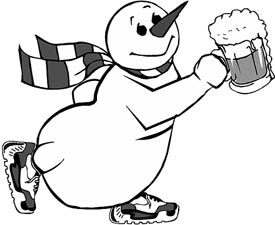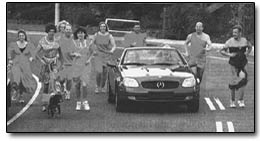|
British-inspired pasttime gives
new meaning to 'making a beer run'
written by Missy Votel

So you think you’ve conquered the
gnarliest physical feats Snowdown has to offer, contorting
your limbs into an overstuffed outhouse, taking a cream
pie in the face and ski joring ‘til your arms hung
like limp noodles? Well, before you hang up your conga
shoes for another year, the slightly twisted minds at
Snowdown announce a new entry in the endurance and debauchery
department: the first official Snowdown Hash House Run.
Despite a name that may indicate otherwise, the pastime
of hashing involves nothing illegal – just runners,
or “harriers,” and an occasional cold adult
beverage, said event planner Matt Kelly. The harriers
are broken down into two groups: the “hares,”
a select group of ringers that leaves a 3-5-mile trail
of flour for the rest of the runners, or “hounds,”
to follow. The concept is simple: the hounds follow the
trail left by the hares to a locale where merriment and
jocularity ensues. However, as is the case with most travel
adventures, getting there is another story – and
half, if not all, of the fun.
 “We
call ourselves a drinking club with a running problem,”
Kelly said. “It’s a fun-loving, irreverent
group.” “We
call ourselves a drinking club with a running problem,”
Kelly said. “It’s a fun-loving, irreverent
group.”
According to Kelly, almost anything is free game in a
typical hash course, including hill, dale, forest, chainlink
fence, shopping malls and even an occasional water hazard.
“I won’t promise that they won’t cross
the river,” he said.
The challenge is further confounded by false trails left
by masochistic hares in an effort to throw off the pack.
All of this is advantageous to the hares, who despite
a 15 minute headstart, sometimes get caught, quite literally,
with their pants down.
“All kinds of nasty things happen to the hares
if they’re caught,” he said.
As if the prospect of public humiliation for their peers
isn’t enough, the hounds also are spurred on by
one of the oldest incentives known to humankind: beer.
According to Kelly, beer is hidden along the hash course
and marked by a “BN” for “beer near.”
 “It
makes ’em run harder and faster to get to the beer,”
he said. “It
makes ’em run harder and faster to get to the beer,”
he said.
And while the sport does involve speed, Kelly said being
the first to finish is not the point of a hash. In fact,
it behooves slower hounds to hang back, letting the FRBs,
or front-running bastards as they’re called, do
all the work.
“It probably helps not to be a runner,” he
said. “That way you let everyone else run ahead
and go down all the false trails. They end up exhausting
themselves, and this benefits the slower runners.”
He also said hashes are split into ability categories,
with longer, steeper and more difficult “Eagle Trails”
for the more hard-core runners and shorter, easier “Turkey
Trails” for the less inclined runners.
Although this will be the first official Snowdown Hash,
Kelly said an unofficial one was held at last year’s
event. It was put on by Kelly and a group of locals with
the help of about 40 members of a Front Range hash group.
He said between 60 and 70 hashers participated in last
year’s run, and that he expects similar crowds at
this year’s hash, a series of three runs.
Kelly said last year’s event was such a success
that afterward, he and his rag tag group were branded
an official hash club, one of 13 in the state.
“We’re pretty loosely organized,” he
said. “Hashes only happen when someone gets inspired.”
Nevertheless, the pastime has gained a solid foothold
elsewhere, with more than 1,500 hash groups holding regular
runs worldwide, according to the World Hash House Harriers,
the closest thing to a governing body the sport has. According
to the group, the rudimentary roots of hashing go back
possibly as far as the activity of running itself. However,
today’s format follows that of an enterprising English
ex-patriate who organized a hash in Malaysia in 1938.
The group took its name from the sub-par offerings of
the Royal Selangor Club (hash house is slang for “cheap
restaurant”), where many expatriate Brits would
dine. According to the World Hash House Web site, the
weekly runs were followed by copious amounts of the local
brew, Tiger beer.
Today, the sport has earned a cult-like following in
the United States, operating for the most part under the
radar screen of mainstream society (although one group
in Wichita, Kans., gained notoriety when flour used in
a hash was mistaken for anthrax). In fact, many veteran
hashers go by their well-earned hash names, which usually
stem from an incident on the hash trail. The pseudonyms,
which range from “Bone Ranger” (a local hasher)
to “Poopatrooper” and “Aqua Lungs”
(use your imagination) are used to protect hashers from
their alter-egos, Kelly said.
“Most are professionals,” he said. “The
names started as a way to hide your identity.”
Nevertheless, Kelly insists hashing is something that
almost anybody with a sense of humor and a pair of running
shoes can appreciate.
“It’s a noncompetitive event,” he said.
“You don’t even have to be a runner. It’s
all for fun and drinking. And you don’t even have
to drink to enjoy it 85 but it helps.”
|

